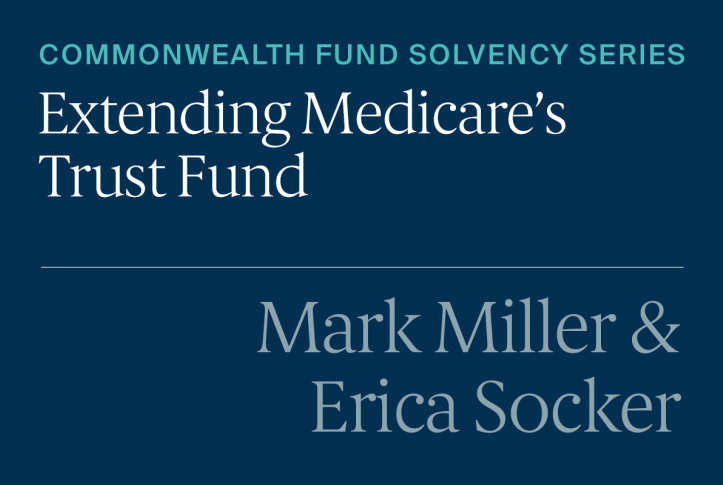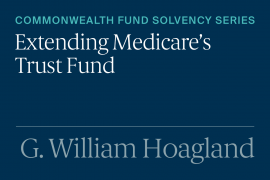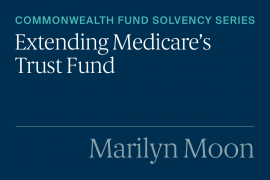The Medicare Hospital Insurance (HI) Trust Fund, which pays for Medicare beneficiaries’ hospital bills and other services, is projected to become insolvent in 2031. Without changes to expected spending or trust fund revenue, the trust fund will not have sufficient funds to cover the entire cost of beneficiaries’ health care. The HI trust fund is primarily funded through payroll taxes paid by employers and employees, with some additional income from interest as well as premiums paid by voluntary enrollees not automatically entitled to Medicare Part A. Will the trust fund solvency be extended by reducing the projected growth in expenditures, raising revenues, changes to the services covered by Medicare Part A, or a combination of these options
To stimulate policy discussions, the Commonwealth Fund asked a group of Medicare thought leaders with a variety of backgrounds and political affiliations to outline how they would extend the life of the trust fund. This series presents their perspectives, highlighting areas of commonality while also putting forth some new ideas for addressing this pressing issue.
Policymakers Should Increase Revenues and Reduce Unnecessary Spending
To extend the solvency of the trust fund, we have two choices: spend less or increase revenues. We believe there is substantial unnecessary spending in Medicare and outline ideas that increase efficiency and payment accuracy without reducing eligibility or benefits. However, achieving savings should not be done solely by reducing spending. We recommend policymakers pursue a balanced approach that also increases revenue by closing certain tax loopholes.
Revenue Proposals
We propose boosting revenues by addressing tax loopholes that allow people to avoid paying Medicare taxes. Given the continued rise in income inequality, policymakers should consider solutions that ensure all business income is subject to Medicare taxes.
Close Tax Loophole and Subject All Business Income to Medicare Taxes ($210 billion over 10 years)
Most earned and unearned income for high-income individuals ($200,000 annual income for individuals and $250,000 for households) is subject to a 3.8 percent tax — either the Medicare payroll tax or the net investment income tax (NIIT). However, individuals can choose to organize their businesses in ways that allow them to avoid these taxes. This option would: 1) ensure that all income for qualifying individuals is subject to one of the existing taxes, and 2) redirect the revenue from the NIIT to the HI trust fund. The revenue estimate above includes the new revenue raised by closing the tax loophole, not the revenue raised by the NIIT under current law.
Spending Proposals
Reduce Excessive Payments to Postacute Care Providers (up to $80 billion over 10 years)
Medicare payments to postacute care (PAC) providers such as skilled nursing facilities, inpatient rehabilitation facilities, and home health agencies have consistently exceeded the cost of patient care for more than a decade. Despite the changes Congress has made over time to PAC provider payments, such as skilled nursing facilities, inpatient rehabilitation facilities, and home health agencies, PAC providers have Medicare margins of more than 10 percent most years. This option would better align PAC payments with their costs by lowering or eliminating their payment rate updates, consistent with previous MedPAC recommendations and proposals included in both the Trump and Obama administrations’ budgets.
Implement Site-Neutral Payments for Hospitals ($40 billion over 10 years)
The Medicare program pays more for medical services delivered in hospital outpatient departments than it pays for the same services performed in doctors’ offices. This creates financial incentives for hospitals to purchase physician practices to receive the higher rate, resulting in more provider consolidation and higher prices in the commercial insurance market.
Medicare should pay the same rate for same service, regardless of the setting where it is provided. Current policy prohibits new hospital-owned physician practices from billing at the higher outpatient department rates. The conservative version of this option ($40 billion) would extend that policy to grandfathered practices as well. A more expansive policy would be to extend these site-neutral payments to hospital outpatient departments by granting the Health and Human Services Secretary authority to pay outpatient departments at the physician fee schedule rate for certain services, resulting in up to $100 billion in savings. The policy would result in savings to Medicare Part B, which could be redirected to the HI trust fund to extend its solvency.
Reform the Quality Bonus Program and Risk-Coding Adjustments in Medicare Advantage (at least $100 billion total over 10 years)
The federal government pays Medicare Advantage (MA) plans more than it does for traditional fee-for-service (FFS) Medicare. About 40 percent of Medicare beneficiaries are currently enrolled in MA, with that percentage projected to grow.
There is evidence that many MA plans engage in aggressive risk coding (i.e., upcoding) that makes MA beneficiaries appear sicker than similar beneficiaries in traditional Medicare, increasing their payments. Implementing MedPAC’s coding recommendations would fully adjust for the remaining coding differences between MA plans and FFS Medicare, and do so equitably across plans.
Rather than being budget-neutral, the MA quality bonus system is financed by added Medicare dollars and allows most plans to qualify for bonuses. An alternative system would be budget-neutral, redistributing quality bonuses and penalties among plans.
Roughly 40 percent of the savings from MA reforms would accrue to the HI trust fund automatically, although all of the savings could be redirected to it.
Alternative Medicare Advantage Policy: Implement Competitive Bidding Among Medicare Advantage Plans (up to $100 billion over 10 years)
An alternative approach would increase fiscal pressure on MA plans by enhancing competition. MA payments are currently determined by their bids against an administratively set benchmark, which is based on spending in traditional FFS Medicare. Currently the benchmarks range from 95 percent to 115 percent of FFS spending. There is evidence that hundreds of counties with substantial MA enrollment submit bids below 95 percent of FFS. The benchmark could instead be determined using a competitive bidding system, which would increase price competition and determine payments to plans based on the bids of other MA plans. This policy has the potential to reduce MA spending by about $100 billion over 10 years.
Implementing competitive bidding in MA would introduce price competition among MA plans, but not between MA and traditional Medicare. A competitive bidding system could be designed where the beneficiary choses FFS or a plan in their market and pays an additional premium if that coverage costs more than the benchmark. There are a series of design issues that would have to be carefully considered to ensure beneficiaries are not exposed to additional costs for the Medicare benefit over time.
Lower the Cost of Prescription Drugs in Medicare (about $100 billion to $450 billion, depending on combination and details)
Medicare Part D spending is unnecessarily high because of the benefit and risk structure of the program, and because manufacturers set and escalate prices in excess of the clinical value of the drug or the cost of research, development, and manufacturing. A number of proposals exist to lower Medicare’s drug spending. Three proposals included in existing House and Senate legislation are:
- modifying the design of the Part D benefit, including the catastrophic portion of the benefit, to increase pressure on plans to aggressively manage drug spending
- implementing an inflation rebate in Medicare Parts B and D, which would require drug companies to pay rebates to the Medicare program if their list prices rise faster than inflation
- requiring the Health and Human Services Secretary to negotiate prices for selected drugs (e.g., drugs without competition that account for substantial spending)
These proposals have varying levels of bipartisan support. These savings would not accrue to the HI trust fund but could be redirected to it.
Conclusion
Even without the current trust fund issue (or the deeper crisis of the ballooning national debt), we would recommend these changes. That said, there are other health care needs and Congress will have to decide where these resources are engaged: to shore up the HI trust fund, address other health care needs, or pay down the debt.







